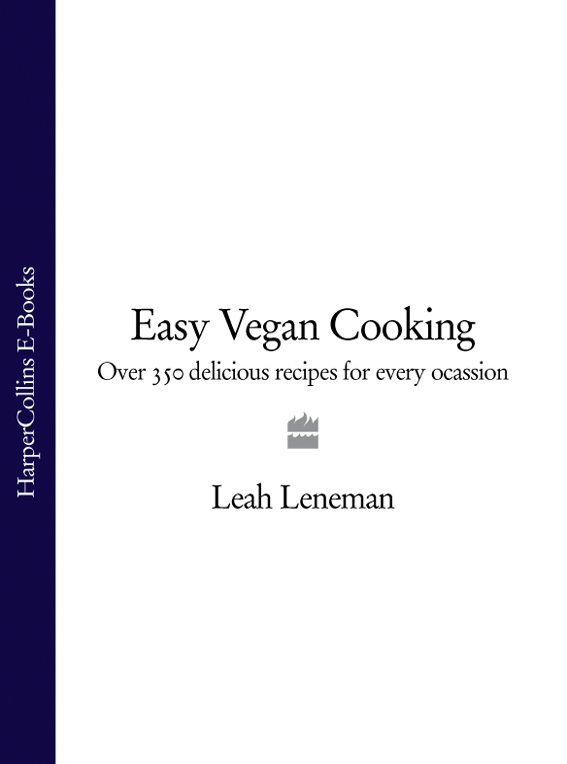
Easy Vegan Cooking
Over 350 delicious recipes for every occasion
Leah Leneman

Contents
My thanks to all who helped with this book-many friends. in particular: Kath Macdonald who suggested ideas for recipes: Alison Crawford who typed the existing recipes into the word processor. and Graham Sutton who tasted most of the dishes.
Some of the recipes in this book have previously appeared in the following; Vegan Cooking, Soya Foods Cookery, Vegetarian Pitta Bread Recipes and The Amazing Avocado.
Vegetarianism is entering a new and dynamic phase. A cuisine based on vegetables, fruits, nuts and grains, flavoured with the herbs and spices of the world, is taking the place of a diet reliant on dairy products. This has come about primarily because of the growing realization that everyone in the world could be fed if a switch were made to a completely vegetarian diet. Britain could be self-sufficient if grazing land were used to grow pulses and grains were fed direct to humans instead of being diverted to animals. Since dairy farming is almost as inefficient a way of using land as beef farming, the switch must be complete if it is to be effective.
It is not only human beings who would benefit for slaughterhouses would disappear. Lacto-vegetarians are beginning to realize that drinking cows milk contributes to animal slaughter. Cows are kept continually pregnant and lactating. their calves usually taken away very shortly after birth (many ending their brief lives as veal), so that the milk can all be sold for human consumption. Even if factory farming were to be abolished, male calves would still have to be slaughtered to maintain the dairy industry. Similarly, in order for hens to lay there must be fertile eggs, and all of the male chicks will be killed. Thus, while free-range hens do not have to endure the inhumane battery system. eating any kind of eggs still contributes to animal slaughter.
There are so many second, third and even fourth generation lacto-vegetarians in this country now that no one could convincingly claim that flesh foods are necessary for health. Many people still fear, however, that to give up all animal produce is dangerous (and anyone who embarks on a vegan diet while riddled with apprehensions may well become ill from sheer anxiety). In fact, many lacto-vegetarians consume an excessive amount of dairy produce, thereby clogging up their arteries with saturated fat a far greater health risk than a vegan diet.
The biggest worry seems to be protein. Giving up cheese and eggs, it is feared, will mean eating only inferior, and therefore insufficient. protein. Fortunately it has become more generally known that cereals can be combined with pulses or nuts to obtain all the necessary amino acids (the building blocks of protein) in required proportions. This combination forms the basis of many of the recipes in this book, making it virtually impossible for anyone using it to become deficient in protein. It is certainly not necessary to eat foods high in protein at every meal, or to worry about food combining.
The one and only nutrient which does not occur naturally in a vegan diet is vitamin B12. Although some pioneering vegans who had never heard of this vitamin appear to have been able to synthesize it in their intestines, the effects of a deficiency are too drastic to make it worth the risk. Most of the plant milks now available in Britain are fortified with vitamin B12 as are most textured vegetable protein (t.v.p.) products and a number of other foods. Yet only a small amount of this vitamin is required, which makes it very easy to incorporate into a vegan diet by eating any of the above foods regularly. (Note, however, that nearly all of the breakfast cereals found at supermarkets which contain vitamin B12 also contain vitamin D derived from an animal source and are not therefore vegan.) For those who prefer not to use processed foods, vegan vitamin B12 tablets are available in health food stores. Incidentally, anyone who argues that a vegan diet cannot be a truly natural one since it lacks an essential vitamin, should realize that the answer lies in our perhaps unnatural level of hygiene, since an all-vegetable diet in a country where produce is not so vigorously cleaned would certainly contain that elusive vitamin.
Honey is a contentious issue as, strictly speaking, it is an animal product, but whether it causes suffering is matter for disagreement. The Vegan Society does not admit those who consume honey as full members, and honey is not used in any of the recipes in this book, although many vegans do eat it.
The concern with animal products usually spills over into other areas as well. Most vegans do not wear leather or use soaps or cosmetics which contain animal products or are tested on animals. Wool production can be cruel, and as for lanolin, the idea of putting sheep fat on ones face is not appealing.
Some vegetarians who are vegan at home find it difficult to maintain the diet elsewhere. This is understandable in view of British restaurants obsession with animal produce, but that culture is changing so that even establishments listed in the Good Food Guide are now aware of the existence of vegans, although they vary greatly in their ability to cater for us. It is easy to get delicious vegan meals in Indian, Chinese and Thai restaurants, and often in Italian and Greek or Middle-Eastern ones as well.
Vegans have varied eating patterns. Some eat only raw foods, some stick strictly to unprocessed wholefoods, while others rely mainly on t.v.p. and vegan convenience meals. Variety is the key-note of this book. The philosophy here is that if the basic diet is one of natural unrefined foods, then there is no harm at all in using a certain amount of good quality processed and packaged foods to add different tastes and textures, as well as to save time.
Vegan cookery can be as quick as any other kind. After all, one of the most popular foods in Britain is baked beans on toast a quick and nutritious vegan snack, particularly if the bread is wholewheat. A number of the recipes in this book can be prepared in half an hour or less. It is simply a question of gearing oneself to the use of a completely different set of foods; once you become used to the idea then no great mental effort is required to prepare tasty, healthy vegan meals. And should anyone still think that vegan food lacks variety, this book will prove just the opposite.
Clarification of some ingredients, quantities etc.
 All recipes serve four unless otherwise stated, but do keep in mind that appetites vary a good deal. I am often astonished at the quantities that are supposed to provide four generous servings in some cookery books, and I am aware that on days when I am feeling very hungry the recipes I create are likely to be more substantial than on days when I have no desire for a big meal; a certain amount of independent judgement is necessary.
All recipes serve four unless otherwise stated, but do keep in mind that appetites vary a good deal. I am often astonished at the quantities that are supposed to provide four generous servings in some cookery books, and I am aware that on days when I am feeling very hungry the recipes I create are likely to be more substantial than on days when I have no desire for a big meal; a certain amount of independent judgement is necessary.
 Many cookery books state that imperial and metric measurements should not be mixed. As far as I am concerned, the recipes in this book are robust enough for imperial, metric and American measurements to be mixed at will. This is home cooking, not biochemistry.
Many cookery books state that imperial and metric measurements should not be mixed. As far as I am concerned, the recipes in this book are robust enough for imperial, metric and American measurements to be mixed at will. This is home cooking, not biochemistry.
Next page

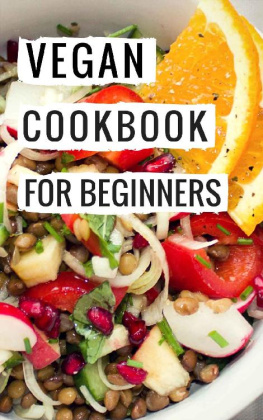
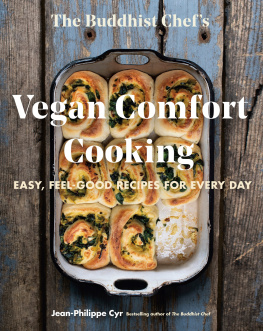
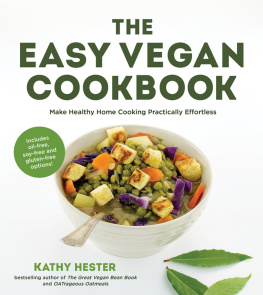
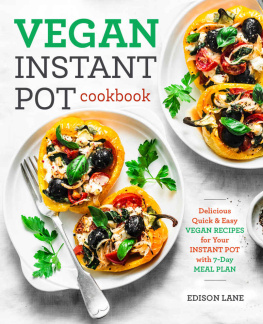
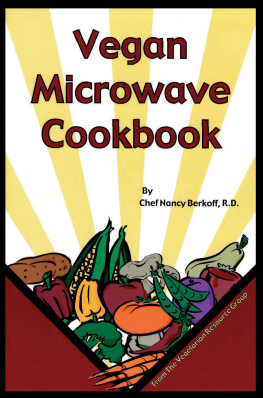
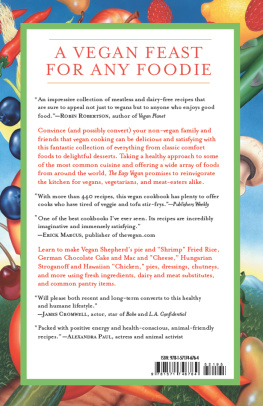


 All recipes serve four unless otherwise stated, but do keep in mind that appetites vary a good deal. I am often astonished at the quantities that are supposed to provide four generous servings in some cookery books, and I am aware that on days when I am feeling very hungry the recipes I create are likely to be more substantial than on days when I have no desire for a big meal; a certain amount of independent judgement is necessary.
All recipes serve four unless otherwise stated, but do keep in mind that appetites vary a good deal. I am often astonished at the quantities that are supposed to provide four generous servings in some cookery books, and I am aware that on days when I am feeling very hungry the recipes I create are likely to be more substantial than on days when I have no desire for a big meal; a certain amount of independent judgement is necessary.